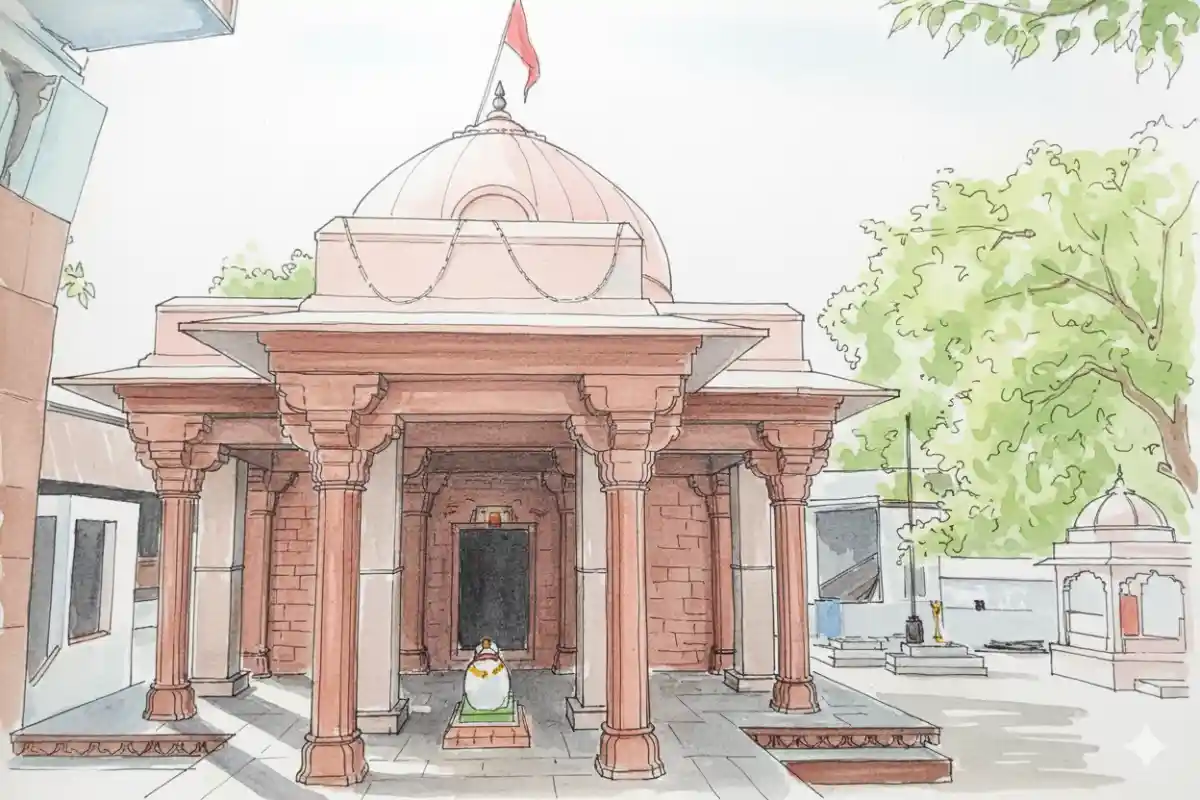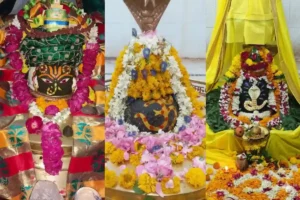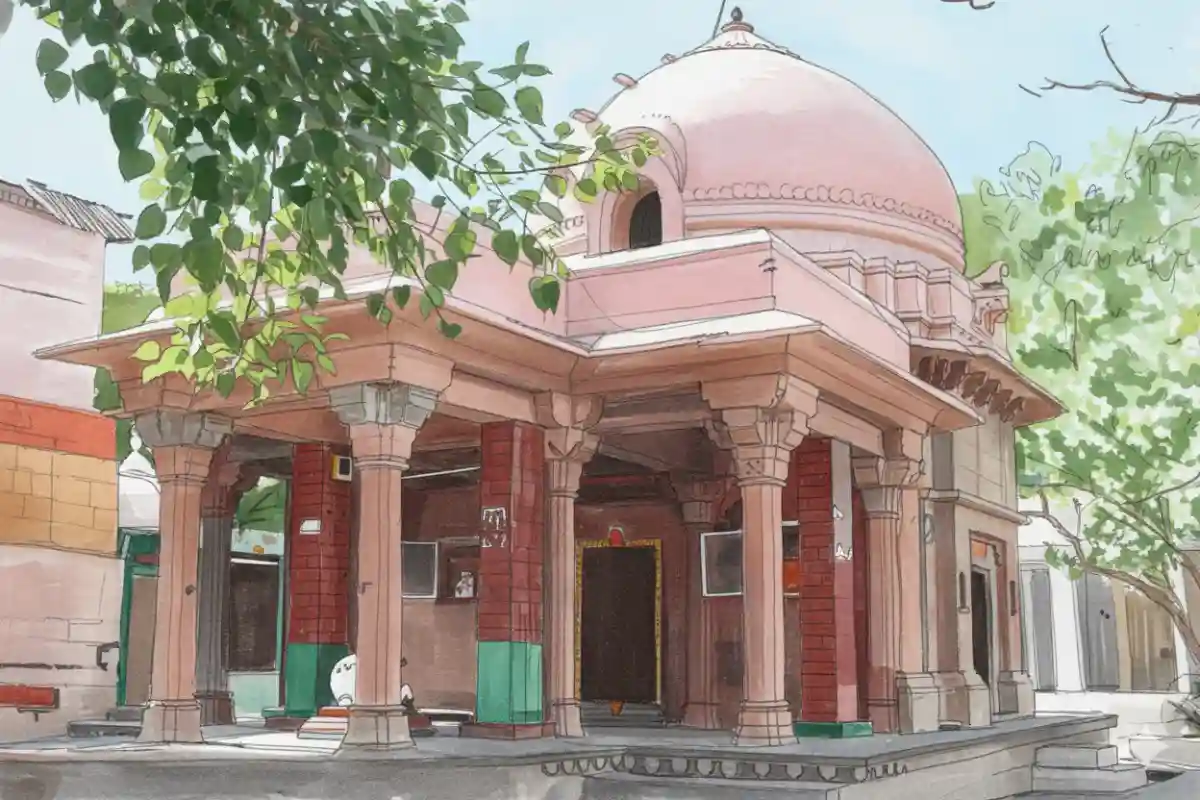The 84 Mahadev Yatra of Ujjain begins with a shrine so ancient, so spiritually charged, that even time seems to bow before it — Shri Agastyeshwar Mahadev, revered as Temple No. 1 in the sacred circuit. Hidden quietly behind the Harsiddhi Mata Temple, the divine lingam here marks the very place where Sage Agastya, one of the most powerful rishis of Sanatana Dharma, performed intense penance and attained spiritual liberation. This is why Agastyeshwar Mahadev holds unmatched significance in the heritage of Ujjain.
For devotees, Agastyeshwar Mahadev is not merely a temple; it is a point of origin — the beginning of the pilgrimage, the first footstep into the Mahakal Forest, and the spiritual threshold from which the entire 84 Mahadev journey unfolds.
The Story of Sage Agastya — When the Devas Sought Help
The earliest references to Agastyeshwar Mahadev appear in ancient Sanskrit verses describing a sacred lingam located in the northern region of Mahakal Van, near the mysterious Vata Yakshini. This lingam, scriptures say, was worshipped by Sage Agastya himself.
A powerful legend narrates the story of how the devas once approached Sage Agastya for help.
There was a time when the asuras (demons) gained immense strength and drove the gods out of heaven. Wandering the earth in fear, the devas finally reached the hermitage of Agastya Maharshi, glowing like the midday sun, seated in deep meditation.
When they narrated their suffering, Agastya’s anger ignited like a blazing fire.
His fury became so intense that it is said the demons were burnt instantly, falling from the heavens. His power was such that other sages, frightened by the sight, retreated to the netherworlds.
But after this event, Agastya felt a deep sense of remorse.
His heart grew heavy with the belief that the fire of anger had destroyed the years of tapas (penance) he had accumulated.
Filled with humility, he approached Lord Brahma for guidance.
Brahma’s Revelation — The Hidden Shivling in Mahakal Forest
Sage Agastya bowed before Lord Brahma and said:
Moved by the sincerity of the sage, Brahma told him:
“In the northern part of the Mahakal Forest lies an ancient and supreme Shivling, protected by the divine Vata Yakshini. Worship that lingam with devotion, and you shall attain moksha.”
On hearing this, Agastya left for the sacred forest of Mahakal, a region believed to have been filled with gandharvas, yakshas, celestial beings, and mystical energies.
Here, he discovered the hidden Shivling — the one that would later be known as Agastyeshwar Mahadev.
Sitting before it, he began intense penance, his austerity shaking the very fabric of the worlds.
Mahakal’s Darshan — The Blessing of Liberation
Pleased by his devotion, Mahadev appeared before Sage Agastya. Wrapped in radiant aura, Lord Shiva spoke:
“Your penance has purified the worlds. From this moment, this Shivling will be known by your name — Agastyeshwar. Whoever worships here with a pure heart shall be liberated from sins and blessed with peace.”
This moment consecrated the temple forever.
From that day, the lingam became a symbol of moksha, tapasya, and supreme purity.
Why Agastyeshwar Mahadev Is the First Temple of the 84 Mahadev Yatra

The sequence of the 84 Mahadev Yatra is not random — it follows a spiritual gradient.
The journey begins with Agastyeshwar Mahadev because:
1. It was worshipped by Sage Agastya — the master of Tapasya
Agastya is among the Saptarishis, known for balancing energy across Bharat. His penance marks the starting point of purification.
2. It lies at the northern gateway of the ancient Mahakal Forest
This region is described in scriptures as the entrance to the divine cluster of Mahadev shrines.
3. The shrine represents the beginning of the moksha marga
Just as Agastya attained liberation here, devotees symbolically begin their journey toward inner cleansing.
4. The sequence follows Purana-based temple geography
Ancient texts mention this lingam among the earliest manifestations in the Mahakal region.
Thus, Agastyeshwar Mahadev becomes the foundation stone of the entire pilgrimage.
Decoding the Scriptural Verse
The verse associated with this shrine reads:
“Mahākāla vane divye yakṣa-gandharva-sevite,
Uttare vaṭa yakṣiṇyā yat talliṅgam anuttamam.”
Meaning:
- Mahakal Forest — the divine forest filled with celestial beings
- Northern region — where the lingam resides
- Vata Yakshini — the mystical guardian spirit
- Anuttamam Linga — the supreme, incomparable Shivling
This reveals the temple’s exact spiritual geography, validating its placement in the 84 Mahadev circuit.
Historical & Spiritual Importance of Agastyeshwar Mahadev
Agastyeshwar Mahadev holds a rare combination of:
Scriptural authority
Referenced in puranic literature linked to Mahakal Van.
Mythological depth
Connected to Sage Agastya’s anger, penance, and liberation.
Spiritual energy
Devotees feel a profound sense of quietude and cleansing.
Foundational placement
Temple No. 1 in the 84 Mahadev route.
Cultural continuity
Locals maintain the oral tradition of Agastya’s penance.
It is believed that those who begin their spiritual journey here receive:
- removal of accumulated sins,
- clarity of mind,
- peaceful inner state,
- successful beginning of the entire 84 Mahadev Yatra.
Temple Architecture & Environment
Unlike grand modern temples, Agastyeshwar Mahadev is simple, ancient, and spiritually grounded.

- The sanctum houses the Shivling worshipped by Agastya.
- The surroundings retain a natural, forest-like energy.
- Nearby shrines include Santoshi Mata Mandir and the sacred Harsiddhi Shaktipeeth.
- Devotees use this location as the assembly point before starting the larger pilgrimage.
Travel Guide — How to Reach Agastyeshwar Mahadev
Location:
Santoshi Mata Temple Premises,
Behind Harsiddhi Temple,
Jaisinghpura, Ujjain (MP)
How to reach:
- From Mahakaleshwar Corridor: 8–10 minutes walking
- From Harsiddhi Temple: 2 minutes walking
- From Ujjain Junction: 3.5–4 km by auto
The route is simple and accessible, especially during the 84 Mahadev Yatra season.
Temple Timings
- Morning: 6:00 AM – 12:00 PM
- Evening: 4:00 PM – 9:00 PM
(Aarti timings vary slightly during festival months.)
Rituals & Best Time to Visit
The most spiritually charged days for worship at Agastyeshwar Mahadev are:
- Shravan Maas (entire month)
- Ashtami Tithi
- Chaturdashi Tithi
- Mondays
Devotees who begin their Yatra here often offer:
- Bilva leaves
- Pure water abhishek
- Deep daan
- Quiet meditation
This sets the tone for the long spiritual journey ahead.
Why Devotees Feel a Strong Presence Here
Pilgrims often report:
- Deep calm
- A sense of ancient energy
- Quiet vibrations of tapasya
- Absence of noise and crowd
- Direct connection to cosmic Shiva tattva
The shrine’s location behind Harsiddhi — the ancient Shaktipeeth — adds to its energetic potency.
Agastya & Ujjain — A Deeper Connection
Sage Agastya is closely linked to:
- Shiva consciousness
- Balance of energies
- Restoring cosmic order
- Purification of the southern direction
- Vedic hymns and secret wisdom
Ujjain, being the navel of the universe (Brahmanda Nabhi), became a natural place for his penance.
Thus, the temple stands not only as a historical memory but as a symbol of cosmic harmony.
Nearby Temples for Integration into 84 Mahadev Circuit
If you begin from Agastyeshwar, the next temples traditionally include:
- Anadi Kalpeshwar Mahadev (5)
- Siddhavat
- Char Dham temples
- Dasha Mahavidya shrines
- Kaal Bhairav
This creates a powerful spiritual loop around the ancient Mahakal Van.
Begin the Yatra Where Agastya Found Liberation
Agastyeshwar Mahadev is not just Temple No. 1 — It is the first breath of the 84 Mahadev pilgrimage. It is where tapasya begins, where the mind becomes silent, and where devotees symbolically restart their spiritual cycle.
For anyone walking the divine path of Mahakal, Agastyeshwar is the doorway. This sacred beginning resonates with timeless traditions recorded in government records on cultural preservation and continues to guide millions of devotees on their spiritual journey.
FAQs
1. Why is Agastyeshwar Mahadev Temple No. 1 in the 84 Mahadev Yatra?
Because the Yatra follows the ancient sequence of Mahakal Forest shrines, and this was the place where Sage Agastya attained moksha.
2. Did Sage Agastya really visit Ujjain?
Yes, many puranic references mention his presence in the Mahakal region, supported by detailed archaeological research on ancient Indian traditions.
3. What is the role of Vata Yakshini here?
She is described as the guardian spirit protecting the hidden Shivling of Agastya.
4. What makes this temple special?
It is the beginning point of the sacred 84 Mahadev route and holds cleansing energy.
5. Is this temple inside Mahakal Corridor?
No, but it is very close — just a few minutes’ walk from Harsiddhi Temple.
For the latest updates on Ancient History, cultural insights, spiritual journeys, and other global events, visit mahakaltimes.com first.











